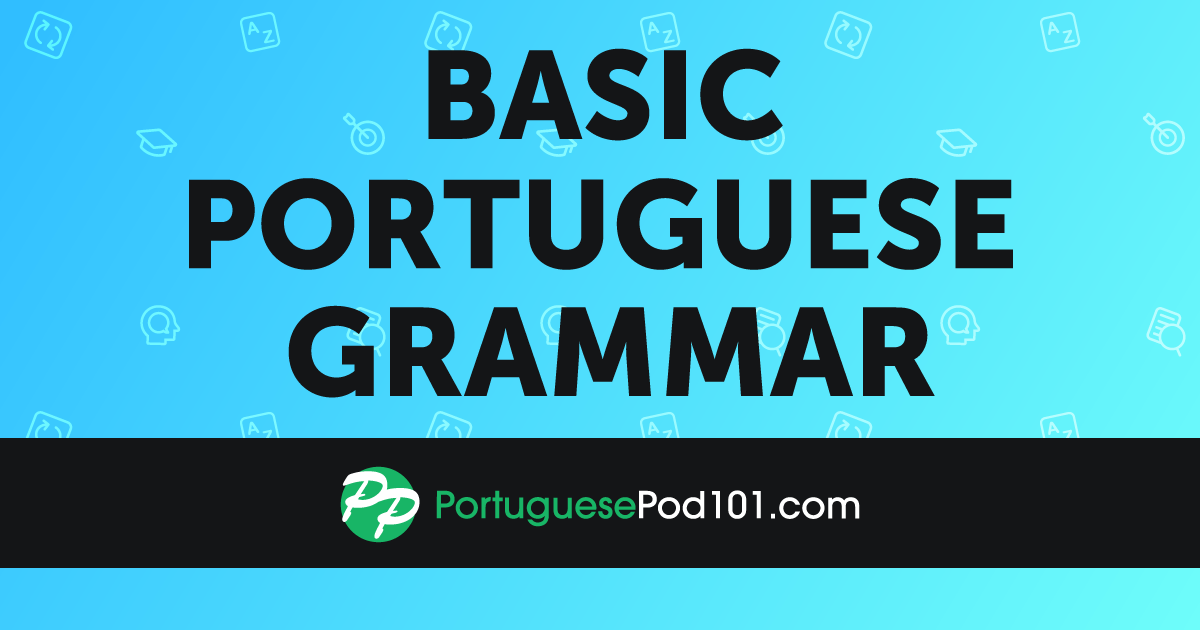
The word “grammar” can be a bit intimidating, especially when learning a new language.
If you’re considering learning Portuguese but are worried about how complicated the grammar is, you are in the right place! This guide will give you an overview of the main Portuguese grammar topics and show you that there’s nothing to be afraid of.
By taking a quick look at the sentence structure, verbs, and grammatical gender and number, you’ll be prepared to handle whatever comes your way. Then, as you continue learning this amazing language, you can always use this overview as a handy reference.
Buckle up for a fast-paced ride! It’s time to discover the ins and outs of Portuguese grammar.
 Table of Contents
Table of Contents
- General Rules
- Sentence Structure
- Building Blocks
- Verbs
- Gender and Number Agreement
- Learn More Portuguese with PortuguesePod101
1. General Rules
First things first: Learning the basic Portuguese grammar rules really isn’t that complicated. There are a few aspects that pose some challenge, and we suggest tackling those head-on. We’ll do our best to make even those complicated bits easier to understand.
As an English speaker, you’ll be glad to learn that Portuguese and English have a lot in common! The languages share similar grammatical structures and even vocabulary, giving you an advantage.
One similarity you’ll encounter from the beginning is the word order, which dictates how the sentence is structured. Both Portuguese and English follow the Subject + Verb + Object structure.
Every sentence is composed of parts that make the whole, and here we find more similarities between the two languages. Many of the parts of speech we use in Portuguese will be familiar to you. These include articles, nouns, verbs, adjectives, adverbs, prepositions, pronouns, and more.
Verbs, in particular, can get a little tricky in Portuguese. We have regular verbs (and we love them!), but we also have to deal with irregular ones. Portuguese verb conjugation introduces different tenses, moods, and people to the mix. It’s a complex topic, but once you learn it, you will have conquered the bulk of Portuguese grammar!
There are a few unfamiliar concepts you’ll need to get a handle on when learning Portuguese grammar as an English speaker. One of them is the way grammatical gender changes the parts of speech. Words like articles and adjectives have to match the gender of the noun, which many new learners find a bit strange. Luckily, this aspect of grammar isn’t too complex and you’ll soon be comfortable with it.
Now, let’s take a closer look at each of these aspects.

English and Portuguese are not all that different.
2. Sentence Structure
The sentence structure refers to the word order in a sentence. There are three main “building blocks” used to form sentences:
1. Subject: Indicates who or what performs the action in the sentence
2. Verb: Describes an action, state, or natural phenomenon
3. Object: Noun or noun phrase acted upon by the subject
Take this sentence as an example:
- Eu acordo cedo. (“I wake up early.”)
As you can see, this basic sentence follows the same structure in both Portuguese and English. And, unlike other languages like French, you won’t be learning any complex inversions for asking questions in Portuguese.
Unlike in English, however, subjects can be implied in Portuguese. Many sentences omit the subject, but people know who or what the subject is thanks to the way the verb is conjugated.
- Viu aquilo? (“Did you see that?”)
Another important difference to keep in mind is that, in Portuguese, the adjective usually follows the noun it refers to. For example:
- Ela gosta de vinho tinto. (“She likes red wine.”)
However, there are some situations where the adjective comes before the noun.
The sentence structure we just saw is the most basic one. As we create more complex sentences and add information, we use modifiers such as adjectives, adverbs, numerals, and more.
But as you begin your Portuguese learning journey, stick to the basics. As you progress, you’ll have plenty of opportunities to discover more.
- → If you want to learn more about the Portuguese sentence structure and adjective placement, be sure to check out our complete article about word order on PortuguesePod101.com.

Subject + Verb + Object
3. Building Blocks
There are several types of words that go into building sentences. After all, you can’t create a sentence with only verbs or only nouns.
Luckily, the word types in Portuguese are familiar to English speakers. If you already know a Romance language, even better!
The Portuguese word classes or types are:
- Verbs indicate actions, occurrences, or states of being.
Eu como muito. (“I eat a lot.”)
- Nouns function as the name of objects, people, places, or ideas. Nouns have gender, as you’ll see later on.
A cama (“The bed“)
- Articles precede a noun. They can be definite or indefinite, and change according to gender and number.
Os carros (“The cars”)
- Adjectives modify or describe a noun. Adjective placement may vary, but in most cases it comes after the noun.
A casa pequena (“The small house”)
- Possessive adjectives are words that indicate to whom a noun belongs.
Meu irmão (“My brother”)
- Adverbs modify words other than nouns and typically express manner, time, frequency, and place. You can identify Portuguese adverbs of manner by the ending -ente (similar to the English ending -ly).
Ele caminha lentamente. (“He walks slowly.”)
- Demonstrative pronouns are words that indicate what is being referred to.
Este livro (“This book”)
- Pronouns are words that substitute for a noun to avoid repetition.
Nós ganhamos o jogo. (“We won the game.”)
- Conjunctions connect other words or phrases.
Você quer café ou chá? (“Do you want coffee or tea?”)
- Prepositions are words that express spatial, directional, and temporal relations between parts of a sentence.
Ela jogou contra mim. (“She played against me.”)
- Numerals describe numerical quantities.
Duas mãos (“Two hands”)
These word classes all play a part in the language. As you advance in your lessons, you’ll enrich your vocabulary and learn words from all different classes, giving you a lot more freedom to build your own sentences.

Every “building block” has a place in the sentence.
4. Verbs
Verbs and their conjugation are a vast world in Portuguese. You’ll encounter many rules and, as always, several exceptions while learning the topic.
Here are some basic concepts to keep in mind.
1 – Verb Endings
Portuguese has three main verbal groups, characterized by their different endings. These verb endings are -AR, -ER, and -IR. For example:
- Amar (“To love”)
- Correr (“To run”)
- Discutir (“To discuss” / “To argue”)
Why are the verb endings important, you ask? Well, they’re helpful because regular verbs in a given group will conjugate the same way as other regular verbs in that group. The stems of the verbs remain the same in each of the different conjugations and the endings are predictable.
Of course, Portuguese also has irregular verbs which do not obey the same rules. Some of them even end in -OR, such as supor (“to suppose” / “to assume”). These derive from the second conjugation (-ER), having had their ‘e’ suppressed as the language evolved.
2 – Conjugation
Verbs change their form depending on several factors, including person, mood, tense, and voice.
Person and tense are the most basic factors you should keep in mind. When we talk about grammatical person, we are referring to the pronouns.
| 1st person singular | Eu | I |
| 2nd person singular | Tu / Você | You |
| 3rd person singular | Ele / Ela | He / She |
| 1st person plural | Nós | We |
| 2nd person plural | Vós / Vocês | You (plural) |
| 3rd person plural | Eles / Elas | They (male) / They (female) |
In Portuguese grammar, tenses are categorized as being simple or compound. The compound ones use another verb (called an auxiliary) alongside the main verb. As you learn Portuguese, you should focus first on the most-used tenses: the simple present, simple past, and simple future.
By putting together the verb endings and the conjugation basics, we can get an idea of how regular verbs look in sentences.
- Verb amar (“to love”), 1st person singular
Eu amo este filme. (“I love this movie.”)
- Verb correr (“to run”), 3rd person plural
Elas correm todo sábado. (“They run every Saturday.”)
- Verb discutir (“to discuss” / “to argue”), 1st person plural
Nós discutimos ontem. (“We argued yesterday.”)
Here’s a more in-depth look at how regular verbs are conjugated based on their ending, in the simple present tense.
| -AR verbs | -ER verbs | -IR verbs | ||||
| Eu | Stem + o | Amo | Stem + o | Corro | Stem + o | Discuto |
| Tu | Stem + as | Amas | Stem + es | Corres | Stem + es | Discutes |
| Você/Ele/Ela | Stem + a | Ama | Stem + e | Corre | Stem + e | Discute |
| Vós | Stem + amos | Amamos | Stem + emos | Corremos | Stem + imos | Discutimos |
| Nós | Stem + ais | Amais | Stem + eis | Correis | Stem + is | Discutis |
| Vocês/Eles | Stem + am | Amam | Stem + em | Correm | Stem + em | Discutem |
- → Check out our extensive guide to Portuguese conjugation on PortuguesePod101.com for many more tips and explanations!
3 – The Verb “To Be”
Unlike English, Portuguese has two verbs that translate as “to be”: ser and estar. You can think about the difference between them in terms of permanence and impermanence.
- → Permanent “to be”: ser
You can be tall, Canadian, or a doctor. Those are all qualities that are permanent or static in the long-term.
For example: Eu sou loira. (“I am blonde.”)
The verb ser conjugates as follows in the simple present tense:
| Eu sou | Nós somos |
| Tu és | Vós sois |
| Ele / Ela / Você é | Eles / Elas / Vocês são |
- → Impermanent “to be”: estar
You can be temporarily cold, in a location, or angry. Estar is used with qualities that are not lasting in the long-term.
For example: Ela está nervosa. (“She is nervous.”)
Here is how the verb estar conjugates in the simple present tense:
| Eu estou | Nós estamos |
| Tu estás | Vós estais |
| Ele / Ela / Você está | Eles / Elas / Vocês estão |
Both verbs also act as auxiliary verbs in specific compound tenses.
- Vocês estão estudando? (“Are you [plural] studying?”)
- Ela foi fotografada na praia. (“She was photographed at the beach.”)
There are many more auxiliary verbs you’ll often see in Portuguese, such as the verb ir (“to go”), ter (“to have”), and poder (“can”).
- → Learn much more about regular, irregular, and auxiliary verbs in our complete guide to Portuguese verbs.

Acordar (“to wake up”) is a verb of the -AR group.
5. Gender and Number Agreement
As hinted at before, some word classes need to agree with the nouns in gender and number. The concept of nouns having gender is a bit unfamiliar to English speakers. But don’t worry; with practice, you’ll get the hang of it without too much trouble!
1 – Nouns
Nouns can be masculine, feminine, or both. Some can even change gender depending on the context! Yes, even inanimate objects.
| Feminine nouns | Masculine nouns |
| Faca (“Knife”) | Garfo (“Fork”) |
| Cama (“Bed”) | Colchão (“Mattress”) |
| Televisão (“Television”) | Computador (“Computer”) |
| Mulher (“Woman”) | Homem (“Man”) |
| Mãe (“Mother”) | Pai (“Father”) |
As a rule of thumb, nouns that end in –o tend to be masculine and nouns that end in –a tend to be feminine. Please note that this isn’t always the case, as in these examples:
- Rádio (“Radio”) can be feminine or masculine, and each one has a different meaning even though the spelling of the word doesn’t change. How do you know which rádio is being referred to? Either by the article used or by the context.
- Masculine: o rádio. Used to talk about the radio set, the object.
- Feminine: a rádio. Used to talk about the radio transmitting station or the communication medium.
- Criança (“Child”) is a noun with a set grammatical gender and works for both male and female children. Even though the feminine article is always used, it can be used to talk about a boy or a girl.
- Masculine: Ele é uma criança inteligente. (“He is a smart child.”)
- Feminine: Ela é uma criança feliz. (“She is a happy child.”)
- Colega (“Colleague”) is another noun that doesn’t change its spelling, but can be used to talk about males or females. However, the article and adjectives change depending on the gender.
- Masculine: Ele é o novo colega. (“He is the new colleague.”)
- Feminine: A Maria é a colega que teve um bebê. (“Maria is the colleague that had a baby.”)
2 – Articles
Portuguese nouns are preceded by definite or indefinite articles which vary depending on the gender of the noun. Likewise, different articles are used when a noun is plural.
| Definite article | Indefinite article | |
| Feminine singular | A → A cama (“The bed”) | Uma → Uma cama (“A bed”) |
| Feminine plural | As → As facas (“The knives”) | Umas → Umas facas (“Some knives”) |
| Masculine singular | O → O colchão (“The mattress”) | Um → Um colchão (“A mattress”) |
| Masculine plural | Os → Os garfos (“The forks”) | Uns → Uns garfos (“Some forks”) |
3 – Adjectives
Adjectives also have to agree with the noun in gender and number.
Some adjectives will change depending on gender, while others don’t. For example:
- Inteligente (“Smart” / “Intelligent”)
Ela é inteligente. (“She is smart.”)
Ele é inteligente. (“He is smart.”)
- Bonita (“Beautiful” / “Pretty” / “Handsome”)
Ela é bonita. (“She is pretty.”)
Ele é bonito. (“He is handsome.”)
Once again, most of the feminine adjectives end in -a, while the masculine adjectives end in -o.
The plural form of the adjectives is very straightforward. Simply look for an -s at the end:
- Os gatos são medrosos. (“The cats are fearful.”) – masculine
- As modelos são altas. (“The models are tall.”) – feminine
Discover the top 50 most common adjectives in Portuguese with PortuguesePod101.

A pipa, o céu. (“The kite, the sky.”)
6. Learn More Portuguese with PortuguesePod101
We hope our overview of the Portuguese grammar basics was helpful to you, and that you’re now feeling more confident as you embark on this amazing language learning journey!
You can also use this page as a refresher or reference point whenever you need a quick explanation of a Portuguese grammar element. Feel free to come back to it as many times as you want.
Are you now ready to start learning more Portuguese? Do you think we forgot an important aspect that you would like covered? Let us know in the comments!
To boost your skills and take them to the next level, continue exploring PortuguesePod101.com. There are lots of free Portuguese grammar resources and themed vocabulary lists to get you started on the right foot. Go ahead and choose your favorite tools to increase your learning opportunities.
If you want to take your learning experience further, members of PortuguesePod101.com get access to the largest language lesson library in the world, with thousands of real lessons by real teachers. Perfect for anyone who wants to learn from anywhere, feel motivated, and be ready to speak Portuguese with confidence.
Happy learning!










